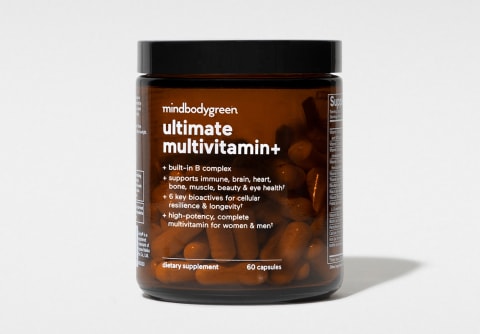Advertisement
How Micronutrient Levels Fluctuate During These Phases Of The Menstrual Cycle


Ashley Jordan Ferira, Ph.D., RDN is Vice President of Scientific Affairs at mindbodygreen. She received her bachelor's degree in Biological Basis of Behavior from the University of Pennsylvania and Ph.D. in Foods and Nutrition from the University of Georgia.

What we eat throughout the day plays a massive role in our overall health and well-being, all the way down to the micronutrients we're consuming. This is particularly true for people who menstruate, according to recent research1 from Penn State University. The study reveals that there are varying nutritional needs and several micronutrient deficiencies during different phases of the menstruation cycle.
The study analyzed a healthy cohort of females aged 18 to 44 with average cycle lengths of 26 to 35 days that were not pregnant, smokers, or taking any medications (including birth control).
Using fertility monitors to determine which days to collect data, blood levels were taken at three key points (early follicular phase, late follicular phase, and mid-luteal phase) during one full cycle so that any changes in the status of key micronutrients they assessed—zinc, copper, magnesium, manganese, vitamin A, and iron—could be identified.
The 4 phases of the menstrual cycle.
Before we dive into the results of the study, here's a refresher on the four phases of the menstrual cycle:
- Menstruation: The menstrual phase begins on the first day of bleeding when progesterone levels plummet, causing the uterine lining to shed. Energy levels are lowest at this point in the cycle, and your body encourages you to take things slow.
- Follicular: Following menstruation, the pituitary gland releases the follicle-stimulating hormone (FSH), which tells the follicles in the ovaries to develop an egg and prepare it for ovulation. Estrogen and testosterone begin to rise during the follicular phase, providing a boost of energy and mood support.
- Ovulation: During ovulation, an egg is released from the ovary and will survive for 12 to 24 hours. If sperm makes its way to the egg for fertilization, this is when conception takes place. Estrogen and testosterone are highest during this phase, causing peak sex drive, energy levels, and self-confidence.
- Luteal: Moving into the luteal phase, estrogen and testosterone levels drop, and progesterone is released in preparation for pregnancy. The desire to stay at home to "nest" and relax is strong during this time, thanks to progesterone's calming effect. Once the reproductive system realizes the egg has not been fertilized, progesterone levels drop, and menstruation begins again.
Micronutrient status during each phase.
Remember, participants' micronutrient levels were tested during the following phases:
- Early follicular phase (during menstruation, when all hormone levels are at their lowest)
- Late follicular phase (around ovulation, when estrogen and testosterone levels are at their peak)
- Mid-luteal phase (in between ovulation and menstruation, when progesterone is at its highest)
Specifically, zinc concentrations dropped 6.6% from the early follicular phase (around menstruation) to the mid-luteal phase, raising zinc deficiency prevalence from 22% to 37% from the start to the end of the menstrual cycle.
Magnesium levels fell 4.5% from the early follicular phase to the mid-luteal phase. The prevalence of magnesium deficiency was even more shocking, increasing from 29% during the early follicular phase to 49% during the mid-luteal phase. In other words, approximately half of the participants were deficient in magnesium between ovulation and menstruation.
Ferritin levels (aka iron stores) dropped the most following menstrual bleeding (i.e., between the early and late follicular phases), decreasing by 15.2%. Due to the lagging body stores of iron, ferritin concentrations continued to drop 5.5% between the late follicular phase and the mid-luteal phase, causing a 19.8% decrease from the start of the menstrual cycle to the end.
Other micronutrients that were tested during the study (i.e., copper, manganese, and vitamin A) did not change significantly throughout the menstrual cycle. Nonetheless, at "baseline" (the early follicular phase), even the trace mineral manganese was lacking, with 13% of women demonstrating a prevalence of low manganese status.
As mbg's vice president of scientific affairs Ashley Jordan Ferira, Ph.D., RDN, explains, "Given that millions of American women of reproductive age fail to consume adequate amounts of these essential minerals day in and day out, the exacerbating trajectories of nutrient status demonstrated in this study are massive."
Ferira goes on to share this important cautionary advice. "If we're not intentional about ensuring nutritional sufficiency each day, then the impact of inevitable nutrient fluctuations during our menstrual cycle throughout our life will be more weighty and have broad, negative health implications. They are called 'essential' nutrients for a reason. They matter."
The bottom line.
The sad truth is that even today, many clinical studies exclude female participants, meaning there's a massive gap in scientific knowledge of how women's bodies operate. This fascinating study gives us a glimpse into how female hormones can affect nutritional needs throughout the menstrual cycle.
To help achieve and maintain sufficient micronutrient levels each day, women should consider taking a comprehensive, high-potency multivitamin like mbg's ultimate multivitamin+ to help buffer against widespread zinc, iron, and magnesium nutrient gaps and promote whole-body well-being.*
Watch Next
Enjoy some of our favorite clips from classes
Enjoy some of our favorite clips from classes
What Is Meditation?
Mindfulness/Spirituality | Light Watkins
Box Breathing
Mindfulness/Spirituality | Gwen Dittmar
What Breathwork Can Address
Mindfulness/Spirituality | Gwen Dittmar
The 8 Limbs of Yoga - What is Asana?
Yoga | Caley Alyssa
Two Standing Postures to Open Up Tight Hips
Yoga | Caley Alyssa
How Plants Can Optimize Athletic Performance
Nutrition | Rich Roll
What to Eat Before a Workout
Nutrition | Rich Roll
How Ayurveda Helps Us Navigate Modern Life
Nutrition | Sahara Rose
Messages About Love & Relationships
Love & Relationships | Esther Perel
Love Languages
Love & Relationships | Esther Perel


















